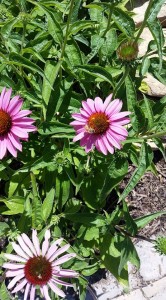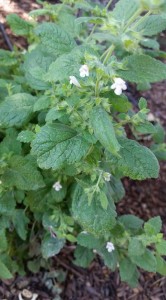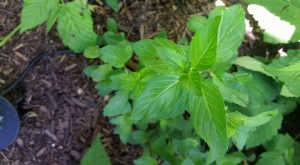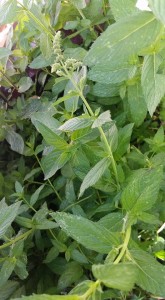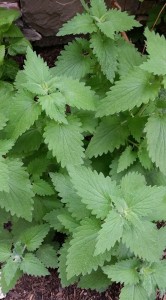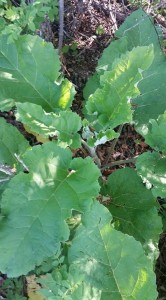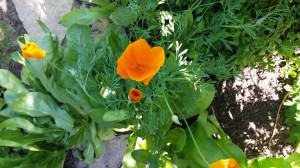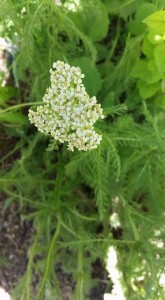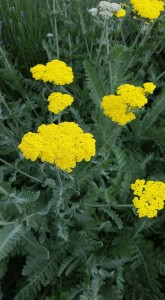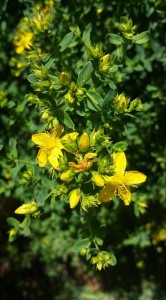Medicinal Herb Post #24 written on June 28, 2018
Cone Flower – Echinacea purpurea, E. angustifolia also in this group is Black Eyed Susan – Rudbekia hirta
This is one really cool plant and is very popular for good reason. It is considered one of the best immune enhancing herbs out there. It can have some residual buildup in the body so it should be used only 2 weeks at a time with breaks in between if using long term.
Echinacea is fairly easy to grow. Mine goes to seed and actually grows like a weed in my yard, but that’s okay I use every bit of it! It loves full sun, but may need to be protected from really hot afternoon days in the summer. Native cone flowers grow wild in the mountains and is considered a drought tolerant plant. Rudbekia is also used just like Echinacea except it is a little stronger. In fact the flowers are almost as strong as its roots. Echinacea is fairly mild and should be used with another simulating herb like, peppermint, cayenne, ginger or yarrow etc. Rudbekia doesn’t need a simulating herb for the body to use it properly. I recently learned that Echinacea is stronger when tinctured fresh. If it has strong medicinal properties it will make your mouth tingle. I like to harvest leaves and flowers as they come on, roots in the fall of 2-3 yr old plants (before and they are too small and after they are too woody) and then the seeds as they ripen on the flower head. You need to grind up the seeds to break up the coating around the seed to release the medicine. Add all those things fresh to the tincture you started in the summer with the leaves and flowers and make a whole plant fresh Echinacea tincture. Steep for another 2-4 weeks. Strain and store in an amber bottle out of direct sunlight. According to Joe Hollis of Mountain Gardens in North Carolina the seed of Echinacea is the strongest medicinally.
As an immune booster that mobilizes white blood cells stimulates the body to produce more T-cells increasing the bodies defense against foreign invaders. It is a strong antibiotic and a good antiviral. It needs to be taken at the onset of an illness every 30 minutes to 2 hours for swollen glands, clogged lymph nodes, sore throat, ear infection, tonsillitis and a fever. If the illness persists and you start to feel worse stop taking it. It can increase cytokines and can make the illness worse. At that point take an herb like grape leaves or garlic to lower cytokines. Look up the Elder post I did a while back for a full list of herbs that increase and decrease cytokines. I like taking it with elder, yarrow and peppermint to kick out a nasty illness. These herbs also help echinacea to work better with in the body. Can be used for 10-14 days.
Echinacea was originally called “snake oil” back in the day. Today that term has a bit of a bad wrap, but it has a purpose and its named is well assigned. Echinacea contains a chemical in it called hyaluronic acid. It’s also found in the body and used to glue our cells back together when damage has been done. Viper snakes, like rattlesnakes and spiders, like brown recluse have a chemical in their venom called hyaluronidase that breaks down tissue, liquifying it. So echinacea does 2 things, it stops the venom from spreading and stimulates the body to produce hyaluronic acid in addition to what’s in the herb. Pretty sweet! A really effective herbal formula for poisonous bites like this would be to use equal parts: Echinacea root or use whole plant (can also use Rudbekia flower or root), Dandelion root to help the liver eliminate toxins, Marshmallow root to soothe and calm tissues so they don’t die and Plantain leaf to help draw out poisons. You would apply a poultice every 3 hours the first day then 2x a day, every 12 hours after that. You can use this same formula for other serious poisonous bites and stings. Echinacea is also really good for bug bites, including mosquito bites. It reacts quickly to foreign pathogens in the body. It can be used on tick bites as a tincture placed on a band-aide and changed every few hours.
Along the lines of using Echinacea to help the body produce more hyaluronic acid, it is very beneficial to use when there has been any damage to joints, cartilage, bones and connective tissues. I have a friend who recently used it along with other herbs like comfrey to heal a bad knee that would eventually need surgery because the cartilage had been worn down. After a month of using it she has felt much relief and can do a lot more than she used too. I have another friend that runs marathons and suffered a stress fracture in her hip. She also used the echinacea along with other herbs and took care of the problem in less than 6 weeks. She’s back to running with no issues. Echinacea needs to be used in large quantities, like 1 tablespoons 3x a day with a one week break every 2 weeks.
The only contraindication for this herb would be for those with autoimmune disease due to it’s ability to stimulate the immune system. For those who can’t use Echinacea, use Astragulus root instead. Astagalus is best used throughout the late fall, winter and early spring months to help strengthen the immune system deep within the bone marrow.

